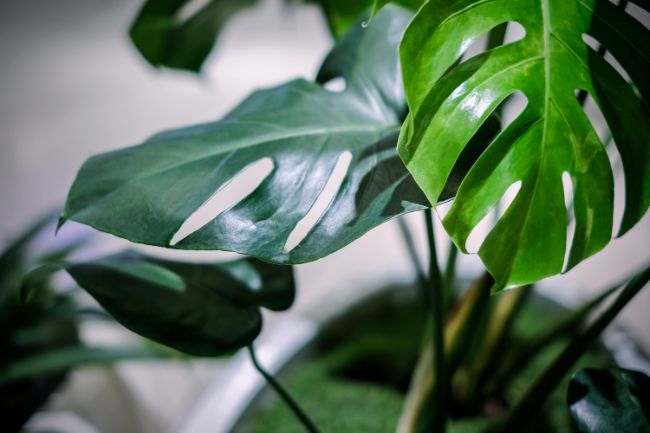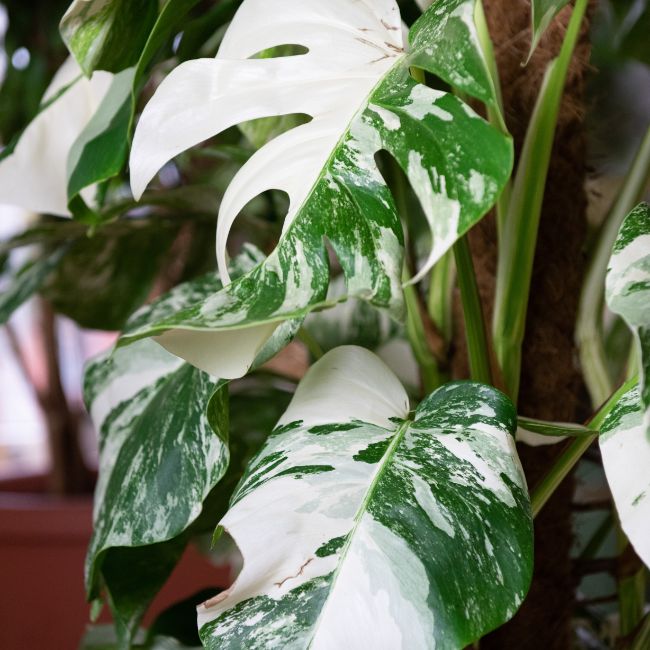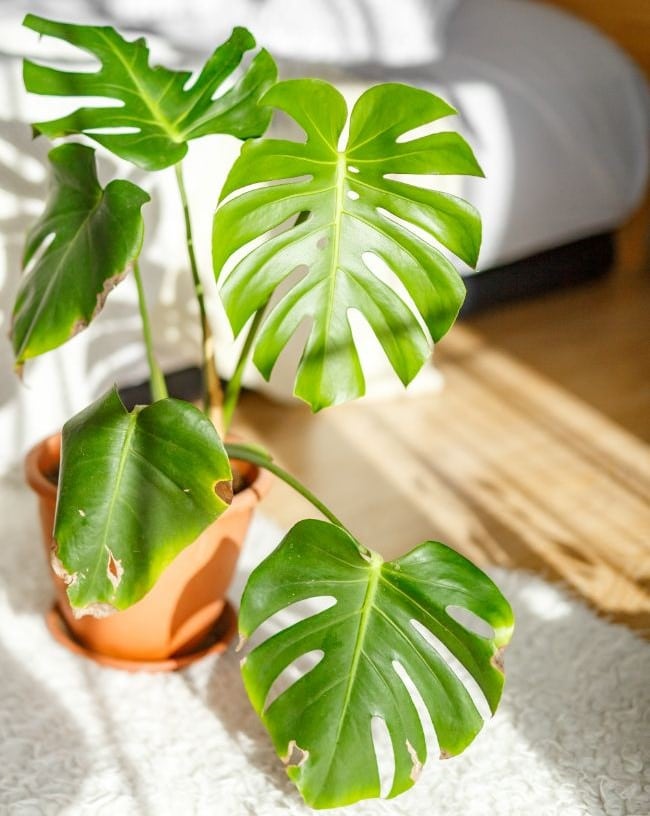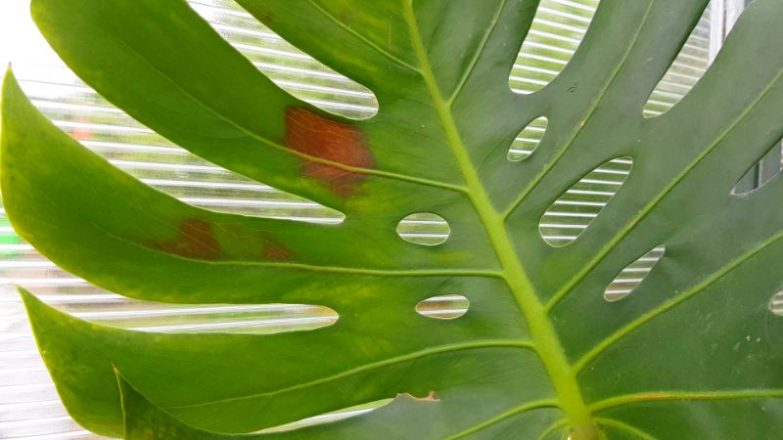Monstera Deliciosa is an elegant beauty of a houseplant, loved so much around the world for its iconic looks. Whilst generally not too difficult to care for, there are a number of common issues you might encounter. If your Monstera has brown spots on the leaves, this article will help you work out what is wrong and get your plant back to its best.
The most common cause of a Monstera having brown spots on its leaves is leaf spot disease caused by overwatering or poorly draining soil. Other problems such as excess direct sunlight, pests, over-fertilizing, underwatering, or sudden temperature changes can also cause brown spots.
Let’s discuss each of these problems in detail to identify the underlying cause and help you fix your plant.
8 Reasons For Brown Spots On Monstera Leaves
Monsteras, when healthy, can grow to be enormous. These plants are native to the rainforests of southern Mexico, so the more you try to re-create the tropical vibe of its natural habitat, the happier it will be.
However, since we cannot actually turn our homes into little rainforests, some mistakes are bound to happen. If you suddenly notice your Monstera has brown spots on the leaves, first of all, breathe!
The cause of most problems can be identified by checking your plant closely, and most issues can be fixed.
Overwatering
Overwatering is a sure-fire way to kill most houseplants, and Monsteras are no exception. Monsteras are epiphytes with aerial roots, so they do not tolerate overwatering too well. These plants require lightly moist soil – soggy soil will cause their roots to rot due to suffocation.
And once the root rot sets in, the plant is likely to show its distress in the form of brown spots on its leaves, as well as brown tips and leaf edges.
Sometimes, poor draining soil or a container with no/inadequate drainage holes might also cause the roots of the Monstera to sit in water for too long, leading to root damage.
How To Fix This?
A good start is to always remember that plants do not need as much water as you think they do. Before giving your Monstera a drink, it is always a good idea to check if the top 2-4 inches of the soil are completely dry. Sometimes, we might notice the top layer of the soil has dried out, but the deeper layers where the roots sit may still have a lot of moisture.
If you feel that root rot has already set in, follow these steps;
- Gently remove the plant from the pot to inspect the roots. Rotten roots will be brown/black, mushy, and may smell bad.
- Use sterile pruning shears to remove any affected roots.
- You can also cut off the leaves that are most affected by brown spots, so the remaining healthy roots can focus on keeping the healthy foliage in good shape.
- Once you’re done pruning the affected roots and leaves, wash the remaining roots with clean water and repot the plant in a new container with plenty of drainage holes.
- Plant your Monstera in fresh, dry soil. A combination of 2/3 potting mix and 1/3 perlite is a good option. Alternatively, these specialist aroid mixes are perfect for Monsteras.
It may take a few weeks for your Monstera to settle into its new environment, but new roots should start to grow within a few weeks, and new leaves will soon follow.

Disease
A brown spot on the leaf of your Monstera could be a sign of fungal or bacterial infection.
Fungal infections usually begin as a single brown spot, which then increase in number over time. If left ignored, these spots start growing in size until they gradually join together and take the form of a large blotch on the Monstera’s leaf. Slowly, the entire leaf turns brown and then eventually, falls off.
Bacterial leaf spot diseases tend to be larger, and fewer in number on the leaves, and can have a wet appearance. Regardless of fungal or bacterial origin, leaf spot diseases require prompt treatment.
How To Fix This?
If you want to give your Monstera a chance at survival, it is imperative that you identify the problem and take steps to stop the infection from spreading.
The moment you notice brown spots developing on its leaves, you should separate it from other houseplants to protect them from getting infected. It is best to trim off the affected leaf/leaves.
You can read my guide to identifying, treating, and preventing common houseplant diseases to learn more.
Is Your Monstera Getting Brown Spots Due To Excess Light?
Many plant parents think that exposing their Monstera to direct sunlight is okay. After all, the plant comes from warm, tropical rainforests!
The reality is that Monsteras actually grow under the canopy of much taller trees. So no direct sunlight reaches these plants. They do get a lot of bright light, but most of it is ‘indirect’.
Too much exposure to direct sun is likely to burn the leaves of your Monstera and cause brown or black spots to develop on its beautiful leaves. Things can get even worse if you have a variegated Monstera as they are even less tolerant of lighting extremes.
How To Fix This?
Monsteras do not like excess light, but you can’t keep it in a dark corner either if you want it to grow those super attractive large, fenestrated leaves that the plant is widely recognized for.
Ideally, you should look for a room that gets lots of bright indirect light and place your Monstera next to the window. Your plant will thank you from the bottom of its heart. Read my guide to lighting for houseplants to learn where to put your houseplants to keep them thriving.

Underwatering
Just like overwatering proves to be detrimental to the health of a Monstera, underwatering is also likely to dehydrate the plant resulting in brown spots on its striking foliage.
Remember that a tropical rainforest is this plant’s natural habitat, so obviously it requires lots of humidity and moisture to thrive – the trick is to provide consistently lightly moist conditions.
Yes, I know that you’re scared of overwatering your Monstera, but just be careful that in your efforts to keep it healthy, you’re not actually depriving it of the moisture that it needs to flourish.
How To Fix This?
Understanding your Monstera’s water requirements is crucial. You should have a fair idea of how frequently it needs a drink. Its water requirements will obviously be greater when the weather is warm and dry, and substantially less during the cool winter months.
Sometimes, a Monstera that is rootbound will also suffer from dehydration as the pot does not have enough soil to hold the water. If that is the case, you’ll have to repot the plant in a bigger container.
A word of caution here – do not increase the size of the container dramatically as that will encourage overwatering and root rot. Just go for one that is a couple of inches bigger.
Pests
Sadly, Monsteras are vulnerable to pests like scale insects and spider mites. Pests are probably your Monstera’s worst enemies as they can have a devastating impact on its overall health. They might cause irreversible damage if not eliminated fast enough.
Spider mites are really tiny and you may not spot the pests initially, but you can look for the following signs. Look for fine, wispy webs between the leaves, as well as browning, curling foliage, with mottled yellow or brown spotting of the leaves.
Look really closely and you will see loads of tiny spider mites no bigger than a pinhead moving around their webs and feasting on your plant.
Scale insects, on the other hand, are known to attack the Monstera’s stem or leaf joints on the foliage. A few tell-tale signs of their presence on your beloved Monstera plant are sudden unexplained leaf drop or yellow/white/brown spots on the leaves, branches or stem.
How To Fix This?
The first thing to do is isolate your plant from your other houseplants to prevent spread. It’s often a good idea to give your plant a thorough wash with a showerhead or hose to dislodge as many of the pests as possible. You can also manually remove larger pests such as mealybugs or scale.
After this initial treatment, the most common and effective method to get rid of pests that infest a Monstera is using a Neem oil spray. Neem oil is not just an effective pest repellent but it also a great sterilant that prevents future breeding of pests too.
Horticultural oil is another effective chemical-free and organic option to get rid of spider mites, scale, and other pests.
For best results, you should mix two teaspoons of Neem or horticultural oil in about one liter of water and add one teaspoon of liquid soap to the mix. After mixing all the ingredients nicely, spray the mixture directly onto the affected foliage.
I would strongly recommend that you repeat this treatment at weekly intervals for several weeks until you are sure all of the pests have been dealt with. Only then can you safely move your plant back to its normal location.
Read my guide to identifying, treating, and preventing houseplant pests to learn more.
Fertilizer Burn
You gave your Monstera a little dose of fertilizer. It responded beautifully and looked great. This tempted you to feed it a little more, secretly hoping that your plant will grow a few feet taller in a fortnight. Sadly, that did not happen and now your beloved houseplant has several brown leaf spots, brown leaf tips, and margins.
Does the story sound familiar? Well, you’re not the first Monstera parent to have committed the mistake of over-fertilizing, and you certainly won’t be the last!
How To Fix This?
If you suspect that the reason behind the brown spots, edges, and tips on your Monstera’s foliage is over-fertilizing, the first thing you should do is flush the soil so that the excess fertilizer salts that have accumulated get washed out. Be careful not to disturb the roots too much.
Then remove the worst affected leaves and make a promise to yourself never to overfeed your Monstera. Read my guide to fertilizing houseplants to get fully up to speed with this important aspect of houseplant care.

Sudden Temperature Changes
If you’ve got this far and still aren’t sure why your Monstera has brown spots, you may be exposing your Monstera to temperature extremes or drafts.
There are several common times that this can happen;
- Plants are often exposed to temperature extremes during delivery or on display in the store, which can cause your plant to suffer shortly after bringing it home.
- Is your plant placed close to a heating or cooling vent, a drafty window, or placed close to a radiator? Make sure to move your plant to a location well away from sudden changes in temperature.
- If you leave your Monstera outside during the summer, remember to bring it in before the cold nights of autumn/fall approach. Cold nighttime temperatures can cause severe temperature stress, causing your Monstera to get brown spots and to wilt.
How To Fix This?
The only way to protect your Monstera from the cold is to move it to a warmer location. Make sure there are no cold drafts near it. Always remember to choose a location for your Monstera that is not directly in front of, or near vents, heaters or air conditioners.
Once you move your plant to a warmer location and tend to it with care, your Monstera will most likely bounce back. You can prune the affected leaves and let the rest of the plant recover.
Acclimation
If you notice your Monstera has brown spots a short while after repotting it or moving it to a new location, it is likely experiencing acclimation. The sudden change in its surroundings might stress the plant, causing it to develop yellow or brown spots on the foliage.
How To Fix This?
When you change houses, doesn’t it take a while to get settled in and call the new place your home? It is the same with plants. If your Monstera is trying to acclimatize to its new environment, all you are required to do is to make it feel welcome in its location by pampering it with the right amount of water, light, and fertilizer… and of course, a generous dose of your love too!
Last Word
Hopefully, you’re well on the way to working out why your Monstera has brown spots on the leaves. Although it’s disappointing to have a plant that’s struggling, I always find that I learn so much more from my mistakes than my houseplant successes.
If you’d like to learn more about caring for Monstera houseplants, check out my other articles listed below.

